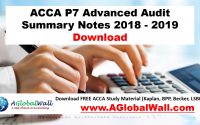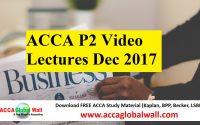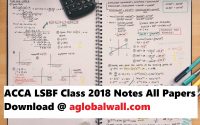What does the Examiner want from Students?
What does the Examiner want from Students?
This is the first question of every student when he couldn’t pass the paper. He wants to know that what did he do wrong in the paper so that he could pass it. What does the Examiner want from Students? The answer to this question is now right Here. The PQMag has shared an article on it. You can read it now.
They had shared the examiner points of view for F5 – F9
What the examiner said after the March 2018 exams…
ACCA F5 Performance Management Examiner Report
It was a worry that in the March report that the examiner talks about topics covered in the ‘December 2017’ exam. We assume that this was an error! The range of topics then that appeared in section B in March 2018 were: costing, linear programming, variances, throughput accounting, short-term decision, and budgeting.
Due to more candidates attempting the CBE format a wider range of syllabus areas were examined. The questions in March were drawn mainly from learning curves, transfer pricing, budgeting, performance management, and CVP analysis.
When it comes to learning curves, the examiner said you have to understand that calculations are based on cumulative, total production. Students also struggle with the topic of transfer pricing. Once the advanced side of transfer pricing comes in very few candidates seem to know the theory. Candidates can comfortably discuss the selling and buying division’s point of view, but few realize that from the company’s perspective (maximizing profits) internal contribution is irrelevant – the question becomes a make v buy decision.
ACCA F6 Taxation Examiner Report
Candidates were presented with questions in section C drawn mainly from tax planning for married couples, computation of the income tax payable by an individual, the self-assessment system for individuals, the child benefit income tax charge, and computation of a company’s corporate tax liability.
ALSO, CHECK THESE ARTICLES;
ACCA F7 Financial Reporting Examiner Report
The examiner has highlighted the areas where March candidates were weak in section B. They are events after the reporting period, leases and different types of revenue, specifical revenue from construction contracts and revenue from contracts that offer both the supply of goods at a specific point in time and services that are provided over a period of time.
For section C the questions were drawn from the areas of preparation of single entity financial statements, analysis of single entity financial statements, preparation of consolidated financial statements, and analysis of consolidated financial statements.
The examiner has asked CBE candidates to ensure that all workings are shown accordingly in both the word processing and spreadsheet response area. Candidates were also advised against putting their entire analysis in a single cell in the spreadsheet. This either gets stretched across a single row and requires the marker to hold and scroll to view or required the marker to ‘unhide’ the information.
ACCA F8 Audit & Assurance Examiner Report
Section A in the March 2018 examination had questions on the following areas: professional ethics & application of ACCA’s code of ethics and conduct, substantive testing including the est on non-current assets and inventory, written representations, audit finalization and review, auditor’s reports.
In Section B the performance in audit procedures questions continues to be disappointing. The examiner said that many candidates remain unable to describe the required number of substantive procedures or, the procedures were often vague. And despite improvements in auditor’s report questions in recent sessions, the performance in March wasn’t so great!
Another ‘very disappointing’ area in March was audit evidence questions. In most cases, candidates remain unable to tailor their knowledge of substantive procedures to the specific issues in the question requirements, with many providing tests of controls rather than substantive procedures, or providing incorrect procedures, or concentrating on one type of test.
Tests of controls are an area of internal controls that students also need to get a handle on. Simply repeating the word ‘check’ does not address the controls identified!
The March exam also tested audit framework and regulation, and planning and risk assessment.
ACCA F9 Financial Management Examiner Report
The examiner said there continue to be some common themes for errors made by candidates on numerical investment appraisal questions. For example, students do not identify correctly relevant cash flows for an investment project or make mistakes with respect to the timing of future cash flows. Another area that caused difficulty was selecting the appropriate discount rate to be used in a lease v buy evaluation.
When it came to business valuation a common error was not excluding internally generated goodwill from an asset-based valuation of a company. The examiner also wondered how many candidates could calculate a conversion premium. Other areas to look at here are price earnings ratio and the Gordon growth model and dividend growth model.
For risk management students struggle to understand the features of risk management derivatives. This is from both a foreign exchange and an interest rate perspective. Candidates struggled to understand of the causes of interest fluctuations and the underlying theories. You might also need to study up on gap exposure and the significance of the types of the gap.
When it comes to financial management environment there is a lack of understanding about measures to reduce stakeholder conflict and what a company should do to maximize shareholder wealth led to errors.
In March, the section C questions were drawn from investment appraisal techniques, allowing for inflation and taxation in DCF, adjusting for risk and uncertainty in investment appraisal, specific investment decisions, sources of and raising business finance, estimating the cost of capital, sources of finance and their relative costs, and capital structure theories and practical considerations.
ALSO, CHECK THESE ARTICLES;








Good morning,
Can l have the link to download learing materials